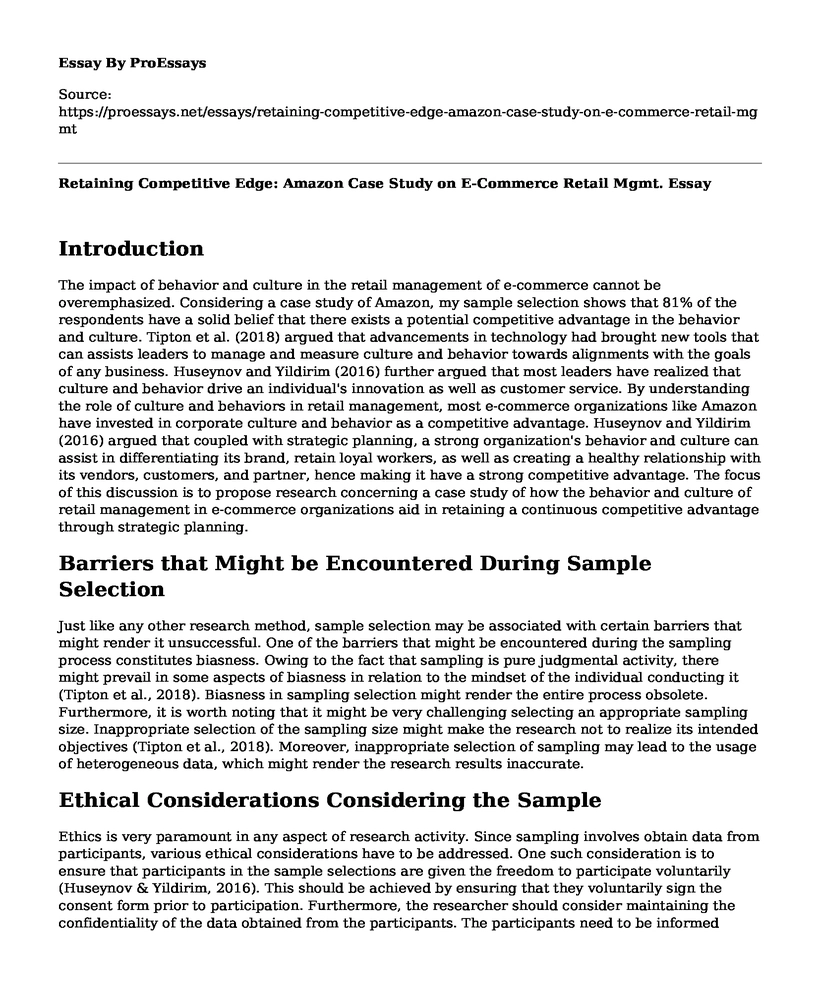Introduction
The impact of behavior and culture in the retail management of e-commerce cannot be overemphasized. Considering a case study of Amazon, my sample selection shows that 81% of the respondents have a solid belief that there exists a potential competitive advantage in the behavior and culture. Tipton et al. (2018) argued that advancements in technology had brought new tools that can assists leaders to manage and measure culture and behavior towards alignments with the goals of any business. Huseynov and Yildirim (2016) further argued that most leaders have realized that culture and behavior drive an individual's innovation as well as customer service. By understanding the role of culture and behaviors in retail management, most e-commerce organizations like Amazon have invested in corporate culture and behavior as a competitive advantage. Huseynov and Yildirim (2016) argued that coupled with strategic planning, a strong organization's behavior and culture can assist in differentiating its brand, retain loyal workers, as well as creating a healthy relationship with its vendors, customers, and partner, hence making it have a strong competitive advantage. The focus of this discussion is to propose research concerning a case study of how the behavior and culture of retail management in e-commerce organizations aid in retaining a continuous competitive advantage through strategic planning.
Barriers that Might be Encountered During Sample Selection
Just like any other research method, sample selection may be associated with certain barriers that might render it unsuccessful. One of the barriers that might be encountered during the sampling process constitutes biasness. Owing to the fact that sampling is pure judgmental activity, there might prevail in some aspects of biasness in relation to the mindset of the individual conducting it (Tipton et al., 2018). Biasness in sampling selection might render the entire process obsolete. Furthermore, it is worth noting that it might be very challenging selecting an appropriate sampling size. Inappropriate selection of the sampling size might make the research not to realize its intended objectives (Tipton et al., 2018). Moreover, inappropriate selection of sampling may lead to the usage of heterogeneous data, which might render the research results inaccurate.
Ethical Considerations Considering the Sample
Ethics is very paramount in any aspect of research activity. Since sampling involves obtain data from participants, various ethical considerations have to be addressed. One such consideration is to ensure that participants in the sample selections are given the freedom to participate voluntarily (Huseynov & Yildirim, 2016). This should be achieved by ensuring that they voluntarily sign the consent form prior to participation. Furthermore, the researcher should consider maintaining the confidentiality of the data obtained from the participants. The participants need to be informed concerning how their data will be used, what will be performed with the audio, photos, materials, and video recordings (Huseynov & Yildirim, 2016). All the activities to be done with their data should be implemented under their consent.
Consideration for Having Access to the Proposed Sample
The success of the research is dependent on the availability and existence of a research sample. It, therefore, follows that certain factors have to be considered in order to have access to the proposed sample. One of the factors that I would consider having consent from the area administration, such as the police officers concerned (Huseynov & Yildirim, 2016). I would explain to them the purpose of the research as well as my propose sample. Seeking consent from authorities would grant me access to the proposed sample.
Conclusion
Most organizations have resorted to capitalize on behavior and culture in the retail management of e-commerce to have a competitive advantage. Established e-commerce organizations such as Amazon have gained a competitive advantage due to their investment in corporate culture and behavior. This has thus enabled them to retain customer loyalty as well as differentiating their brand. The sample selection that was based on the Amazon case study will be characterized by certain barriers such as biasness that might render it ineffective. However, certain ethical considerations such as consent by participants and confidentiality should be upheld to ensure that the entire process is successful.
References
Huseynov, F., & Yildirim, S. (2016). Behavioral issues in B2C E-commerce. Information Development, 32(5), 1343-1358. https://doi.org/10.1177/0266666915599586
Tipton, E., Hedges, L., Vaden-Kiernan, M., Borman, G., Sullivan, K., & Caverly, S. (2014). Sample selection in randomized experiments: A new method using propensity score stratified sampling. Journal of Research on Educational Effectiveness, 7(1), 114-135. https://doi.org/10.1080/19345747.2013.831154
Cite this page
Retaining Competitive Edge: Amazon Case Study on E-Commerce Retail Mgmt.. (2023, Apr 20). Retrieved from https://proessays.net/essays/retaining-competitive-edge-amazon-case-study-on-e-commerce-retail-mgmt
If you are the original author of this essay and no longer wish to have it published on the ProEssays website, please click below to request its removal:
- Becoming an Effective Leader - Paper Example
- Approaches to Ethical Decision Making Essay
- Risk and Reward Assessment Paper Example
- Article Analysis Essay on "Good to Great" Jim Collins
- Paper Example on Exploring Kurt Lewin's Change Theory for Project Proposal
- Essay Sample on Unlocking Sustainability: Leveraging Porter's Strategy for Profitability
- Essay Example on Kobe Bryant: Leadership Style, Filmmaker, & Hollywood Stardom







